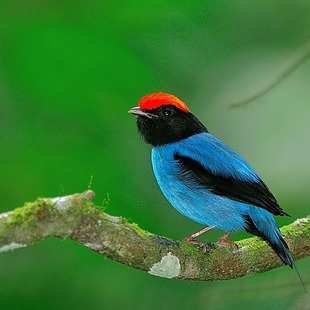Classificação Científica
| Reino: | Animalia |
| Filo: | Chordata |
| Classe: | Aves |
| Ordem: | Passeriformes |
| Subordem: | Tyranni |
| Infraordem: | Tyrannides |
| Wetmore & Miller, 1926 | |
| Parvordem: | Tyrannida |
| Família: | Pipridae |
| Rafinesque, 1815 | |
| Subfamília: | Ilicurinae |
| Prum, 1992 | |
| Espécie: | C. caudata |
Nome Científico
Chiroxiphia caudata(Shaw & Nodder, 1793)
Nome em Inglês
Swallow-tailed ManakinBlue Manakin
Also known as Swallow-tailed Manakin, the Blue Manakin inhabits humid forest and secondary woodland where it is noted for its unmistakeable plumage and song and for its habit of lekking males trying to attract a female.
Characteristics
It is about 15cm in size and exhibits strong sexual dimorphism. The males are generally sky-blue with a black head and chin and bright red crown. The wings and tail are black with elongated central retrices. Young males are olive-green like the females but differ in having the red crown which appears before the remaining plumage moves to that of an adult male. It reaches full adult plumage after two years.
Females are olive-green but also have the elongated retrices on what is a slightly longer tail. They are also quieter than the males.
Food
Breeding
Females have their own territory around the nest which is made of dry plant fibres, moss and leaves and is suspended from a fork high up in a tree. Two eggs which are greyish with dark spots are laid. Incubation is carried out by the females and lasts 18 days. 20 days after hatching the fledglings leave the nest and start to feed and look after themselves.
Habits
Males, normally between 2 to 6 of them, congregate on slender, horizontal branches to display in traditional areas or leks. There is a hierarchy amongst the males that can persist for years. The males perform an intriguing display consisting of a frenzy of cartwheeling by the participating males and often ending with the dominant male in a slow flight display leading to copulation with the single female that the whole display has attracted.
Distribution
It is found in the Atlantic Rain Forest from the south of Bahia (with a photo by Joao Quental from Boa Nova) to Rio Grande do Sul and into Paraguay and Argentina (Province of Missiones).
References
- Roman, C., Della-Flora, F., Broudt, M. S., Caceres, N.C, DIFERENÇA DE COMPORTAMENTO DE CHIROXIPHIA CAUDATA (AVES, PIPRIDAE) EM DIFERENTES ESTRATOS FLORESTAIS NO SUL DO BRASIL, 28 de Set de 2007. Disponível em: http://www.seb-ecologia.org.br/viiiceb/pdf/1943.pdf. Acessado em 03 fev 2009.





















